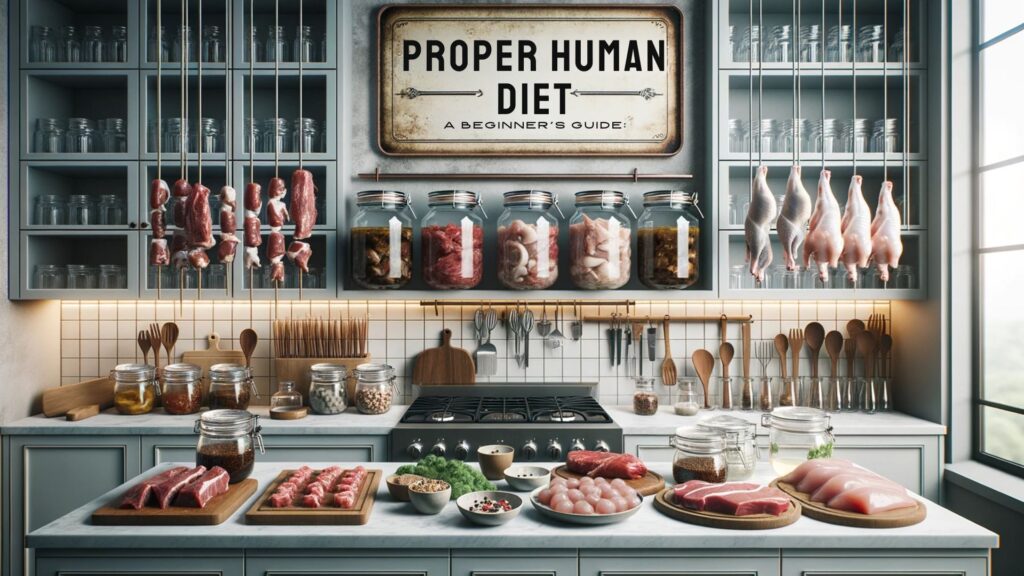Diet Adaptation for Budget Constraints: Strategies for Adopting a Carnivore Diet and Proper Human Diet with Limited Financial Resources
Introduction
Embracing a carnivore diet, often referred to as the “Proper Human Diet,” focuses on consuming primarily animal-based foods, including meat, fish, and other animal products, while excluding plant-based foods. This diet, rooted in the belief that early human diets were predominantly carnivorous, emphasizes high protein and fat intake, often seen as a pathway to improved health and well-being. However, a common hurdle faced by many is the perceived expense of maintaining such a diet. The cost of high-quality meats and other animal products can be daunting, particularly for those on a tight budget.
This article aims to dispel the notion that a carnivore diet is inherently costly. We will explore practical strategies and effective tips for adapting to a carnivore diet without straining your finances. From choosing less expensive cuts of meat to smart shopping techniques, this guide will provide a comprehensive roadmap for those seeking to follow the carnivore diet while adhering to budget constraints. By focusing on affordable yet nutritious options, we will demonstrate that a carnivore diet can be both financially feasible and beneficial to your health.
Key Takeaways: Smart Strategies for a Budget-Friendly Carnivore Diet

Embracing Affordable Meat Choices: Ground Beef and Organ Meats
Ground beef emerges as a champion in the carnivore diet for those on a budget. It’s not only wallet-friendly but also versatile, fitting into a myriad of recipes. Similarly, organ meats like liver and kidneys, often overlooked, are packed with nutrients and are more economical compared to popular cuts.
The Power of Meal Planning and Bulk Purchases
Planning your meals ahead and buying in bulk can dramatically cut down costs. Bulk purchases, especially during sales, offer a practical approach to managing your diet economically.
Diversifying Protein Sources: Eggs and Canned Fish
Eggs and canned fish such as tuna and sardines are excellent, budget-conscious additions to the carnivore diet. These items offer high nutritional value at a lower cost, ensuring a balanced approach to your protein intake.
By focusing on these key strategies, you can successfully navigate the carnivore diet without burdening your budget.
For a well-rounded and practical approach to the carnivore diet, check out the “Proper Human Diet Recipes: A 7-Day Meal Plan” available at Proper Human Diet PhD. This resource offers a variety of meal ideas and recipes that align with the carnivore lifestyle, helping you plan your week with ease.
Understanding the Carnivore Diet Basics: Embracing a Natural Approach to Health

The Essence of the Carnivore Diet
The Carnivore Diet, often referred to as the “Proper Human Diet,” is grounded in the philosophy of consuming exclusively animal-based products. This diet is rooted in the belief that our ancestors thrived on a carnivorous diet, suggesting that such a dietary pattern is more aligned with human biology. It consists primarily of meats, fish, eggs, and select dairy products, offering a zero-carb, high-protein, and high-fat nutritional profile.
Nutritional Benefits
The Carnivore Diet is abundant in essential nutrients. It provides high-quality protein, crucial for muscle growth and repair, and fats, which are vital for hormone production and brain health. This diet is particularly rich in vitamins and minerals such as Vitamin B12, Zinc, Iron, and Omega-3 fatty acids, all pivotal for optimal body functioning.
Positive Health Impacts
Many who adopt this diet report transformative health benefits. These include significant weight loss, enhanced energy levels, mental clarity, and an overall sense of well-being. Additionally, individuals with autoimmune conditions and inflammatory disorders often notice symptomatic relief attributed to the elimination of potential dietary irritants found in plant-based foods.
Adaptation and Ease of Transition
Transitioning to the Carnivore Diet can be surprisingly smooth. The diet’s satiating nature can lead to a natural reduction in hunger pangs and cravings, making it easier to maintain. While some might experience a brief adaptation period, most find that their bodies quickly adjust to the new energy source, resulting in sustained energy levels and improved digestive health.
Environmental and Ethical Considerations
The Carnivore Diet also emphasizes the importance of responsible sourcing of meat. Proponents advocate for ethically raised, grass-fed, and pasture-raised animal products. This approach not only supports animal welfare but also contributes to environmental sustainability.
In summary, the Carnivore Diet presents a compelling approach to nutrition that aligns with our ancestral dietary patterns. It offers a simple yet nutrient-rich diet that many find leads to improved health outcomes and a greater connection to natural food sources.
Prioritizing Cost-Effective Meat Choices in the Carnivore Diet

Discovering the Value in Less Expensive Cuts
Adopting a carnivore diet doesn’t have to strain your budget if you know where to look. Cheaper cuts of meat like ground beef, chuck roast, short ribs, stew meat, and beef shank offer a budget-friendly gateway to maintaining this diet. These cuts are not only affordable but also rich in flavor and nutrients.
Ground Beef: A Versatile and Affordable Option
Ground beef stands out as a versatile and economical choice. It’s perfect for a range of dishes, from burgers to meatballs, and can be a delightful addition to your carnivore diet. Rich in protein and essential nutrients, ground beef can be a foundational element of a cost-effective carnivore diet.
Chuck Roast and Short Ribs: Flavorful and Nutrient-Dense
Chuck roast and short ribs offer deeper flavors and are excellent for slow cooking. These cuts are rich in connective tissue, which, when cooked slowly, results in tender, flavorful meat that’s also packed with collagen, beneficial for joint health.
Stew Meat and Beef Shank: Ideal for Slow-Cooked Meals
Stew meat and beef shank are perfect for slow-cooked dishes. These cuts become exceptionally tender and flavorful when cooked over low heat for extended periods. They are excellent sources of protein and minerals, such as iron and zinc, which are essential for overall health.
Preparing Economical Cuts Tastefully
Cooking these less expensive cuts in a way that brings out their best requires some culinary creativity. Slow cooking, braising, and stewing are excellent methods to transform tougher cuts into succulent, delicious meals. Herbs and spices can enhance the natural flavors of the meat, making each meal both nutritious and enjoyable.
In conclusion, a carnivore diet can be both budget-friendly and nutritious by choosing the right cuts of meat. By exploring these economical options and cooking them with care, you can enjoy a variety of tasty, healthful meals without overspending.
The Role of Eggs, Canned Fish, and Organ Meats in a Budget-Friendly Carnivore Diet

Eggs: A Nutritional Powerhouse
Eggs are a staple in a budget-conscious carnivore diet. They are an excellent source of high-quality protein and contain all nine essential amino acids. Eggs are also rich in vitamins, including B12, which is crucial for brain health, and Vitamin D, which is important for bone health. They’re incredibly versatile – you can boil, scramble, fry, or even bake them into various dishes, making them a convenient and cost-effective choice.
Canned Fish: Affordable and Nutrient-Dense
Canned fish, such as sardines and tuna, is another budget-friendly option. These fish are not only affordable but also packed with omega-3 fatty acids, which are beneficial for heart health and cognitive function. Canned fish can be enjoyed straight from the can or used in simple recipes like salads or casseroles. They are a convenient way to add high-quality protein and essential nutrients to your diet without breaking the bank.
Organ Meats: An Overlooked Superfood
Organ meats, though often overlooked, are incredibly nutritious and economical. Liver, for example, is one of the most nutrient-dense foods available, rich in Vitamin A, iron, and B vitamins. Heart and kidney are also packed with nutrients and offer unique flavors. Organ meats can be grilled, sautéed, or incorporated into stews and soups. They provide a variety of textures and flavors to your diet, along with a host of essential nutrients.
Preparing and Incorporating These Items
To make the most of these affordable protein sources, creativity in the kitchen is key. For eggs, consider dishes like omelets or frittatas, where you can add different herbs and spices. Canned fish can be elevated with a simple mix of olive oil, lemon, and seasonings. When it comes to organ meats, marinating or slow cooking can enhance their flavors and make them more palatable.
Incorporating these budget-friendly options into your carnivore diet not only helps in managing your food expenses but also ensures a diverse and nutrient-rich meal plan. With a little culinary creativity, eggs, canned fish, and organ meats can be delicious, nutritious, and an integral part of your diet.
Shopping Smart: Bulk Purchases and Local Butchers for the Carnivore Diet

Embracing Bulk Purchases for Long-Term Savings
Buying in bulk is a cornerstone strategy for following a carnivore diet on a budget. Purchasing larger quantities of meat often results in a lower cost per pound, leading to substantial savings over time. Bulk buying is especially effective for staples of the diet, like ground beef, chicken, and pork. Many stores offer discounts for larger quantities, and warehouse clubs like Costco can be great sources of bulk meat at competitive prices.
The Benefits of Sourcing Meat from Farms and Local Butchers
Forging relationships with local butchers and sourcing directly from farms can be incredibly advantageous. Local butchers often provide high-quality, ethically sourced meat and may offer cuts that are not typically available in supermarkets.
They can also offer valuable advice on the best cuts for your needs and budget. Purchasing directly from farms, especially those practicing sustainable farming, ensures fresher produce and supports local agriculture. Moreover, some farms offer the option to buy a portion of an animal (like a half or quarter cow), which can significantly reduce the overall cost.
Understanding supermarket deals and the meat grading system is crucial in making informed purchases. Supermarkets frequently have sales and markdowns on meat, so keeping an eye on these can lead to good deals.
Additionally, understanding the USDA meat grading system (Prime, Choice, and Select) helps in making cost-effective choices without compromising on quality. While Prime grade meat is known for its marbling and flavor, Select and Choice grades can offer a more budget-friendly alternative with a good balance of quality and price.
In conclusion, smart shopping through bulk purchases, building relationships with local butchers, and understanding supermarket deals and meat grading systems can make a carnivore diet more accessible and affordable. These strategies not only help in managing the budget but also ensure a steady supply of high-quality meat for your dietary needs.
Meal Planning and Frequency for Cost-Efficiency in the Carnivore Diet

Optimizing Meal Frequency for Budget and Health
One of the key strategies for maintaining a carnivore diet on a budget is to optimize meal frequency. Eating fewer, larger meals can be more cost-effective and time-efficient. This approach aligns with the diet’s high satiety factor due to its rich protein and fat content.
By having 1 to 2 substantial meals a day instead of multiple smaller ones, you can reduce overall food costs while still meeting your nutritional needs.
Benefits of Larger, Nutrient-Dense Meals
Larger meals in a carnivore diet are typically rich in proteins and fats, which provide sustained energy and keep you feeling full longer. This can lead to natural appetite regulation and potentially reduce the temptation for unnecessary snacking or impulse buys. Nutrient-dense meals ensure that despite eating less frequently, your body receives all the essential nutrients it requires for optimal function.
Sample Meal Plans for Cost-Effective Carnivore Eating
A sample day on a budget-friendly carnivore diet might include:
- Breakfast: Skip breakfast, leveraging the benefits of intermittent fasting.
- Lunch: A hearty serving of ground beef patties, seasoned and grilled, paired with a few hard-boiled eggs.
- Dinner: A slow-cooked chuck roast or beef stew, utilizing affordable cuts that yield more servings.
Easy Recipes for Budget-Friendly Meals
Consider simple yet delicious recipes like:
- Slow-Cooked Beef Shank: Seasoned with salt, pepper, and herbs and cooked until tender.
- Pan-Seared Liver: Liver slices lightly fried with onions for added flavor.
- Canned Sardine Salad: Mixed with boiled eggs and a dash of olive oil for a quick, nutritious meal.
By focusing on meal planning and reduced meal frequency with larger, nutrient-dense meals, you can make the carnivore diet both affordable and enjoyable. This approach not only saves money but also aligns with the health benefits of consuming a high-protein, high-fat diet.
Additional Tips for Saving on a Carnivore Diet

Leveraging Sales, Markdowns, and Seasonal Deals
Maximizing savings on a carnivore diet involves a strategic approach to shopping. Keep an eye out for sales and markdowns at your local grocery stores and supermarkets. These discounts can be especially significant during seasonal promotions or when stores need to move inventory quickly. Purchasing meat that’s on sale and freezing it for later use can lead to substantial savings over time.
Cultivating Relationships with Local Butchers
Developing a relationship with your local butcher can be highly beneficial. Butchers often have insider knowledge about the best deals and may offer special prices on less popular cuts that are just as nutritious and delicious as their more sought-after counterparts.
They can also provide custom cuts or bulk deals that aren’t typically available in regular stores. By regularly visiting and buying from local butchers, you may gain access to exclusive offers and high-quality meat at lower prices.
By incorporating these additional tips into your carnivore diet strategy, you can further reduce costs while maintaining a nutritious and satisfying meal plan. Keeping abreast of sales and building connections with butchers are practical ways to make the carnivore diet more affordable.
Conclusion: Thriving on a Budget-Conscious Carnivore Diet

Adopting a carnivore diet while managing budget constraints is entirely achievable with the right strategies. By prioritizing cost-effective meat choices like ground beef and organ meats, leveraging bulk purchases, and building relationships with local butchers, you can enjoy the benefits of this diet without overspending.
Incorporating nutrient-dense foods like eggs and canned fish adds variety and ensures a balanced approach. Regularly seeking out sales and seasonal deals further reduces costs.
Remember, the key is to personalize these strategies to fit your lifestyle and budget, making the carnivore diet both sustainable and enjoyable. Explore these tips and find what works best for you, ensuring a nutritious diet that aligns with your financial goals.
FAQs: Adopting a Carnivore Diet on a Budget
Can I maintain a carnivore diet economically?
Yes, a carnivore diet can be maintained economically by choosing less expensive cuts of meat, such as ground beef, chuck roast, and organ meats. Buying in bulk and seeking out sales also contribute to cost savings.
Are there affordable protein sources for a carnivore diet?
Eggs and canned fish like sardines and tuna are excellent, budget-friendly protein sources. They offer high nutritional value and can easily be incorporated into various meals.
How can I save money on meat purchases?
Consider buying meat in bulk, especially when on sale. Building relationships with local butchers can also lead to access to special deals and less popular, more affordable cuts.
Is it more expensive to eat a carnivore diet compared to a regular diet?
While some cuts of meat can be expensive, a carnivore diet can be cost-competitive with a regular diet when focusing on economical meat choices and utilizing strategies like bulk buying and taking advantage of sales.
Can I get all the nutrients I need from a budget carnivore diet?
Yes, a well-planned carnivore diet, even on a budget, can provide all the necessary nutrients. It’s important to include a variety of meat types, including organ meats, to ensure a well-rounded intake of nutrients.
By addressing these common questions, you can see that adopting a carnivore diet on a budget is feasible with careful planning and smart shopping strategies.
For a comprehensive guide on meal planning and recipe ideas tailored to the carnivore diet, check out this detailed article on the “Ultimate Carnivore Diet Meal Plan: A Guide to Eating Meaty & Healthy” at Proper Human Diet PHD. It offers insightful tips and creative meal options to enhance your carnivore diet experience.


